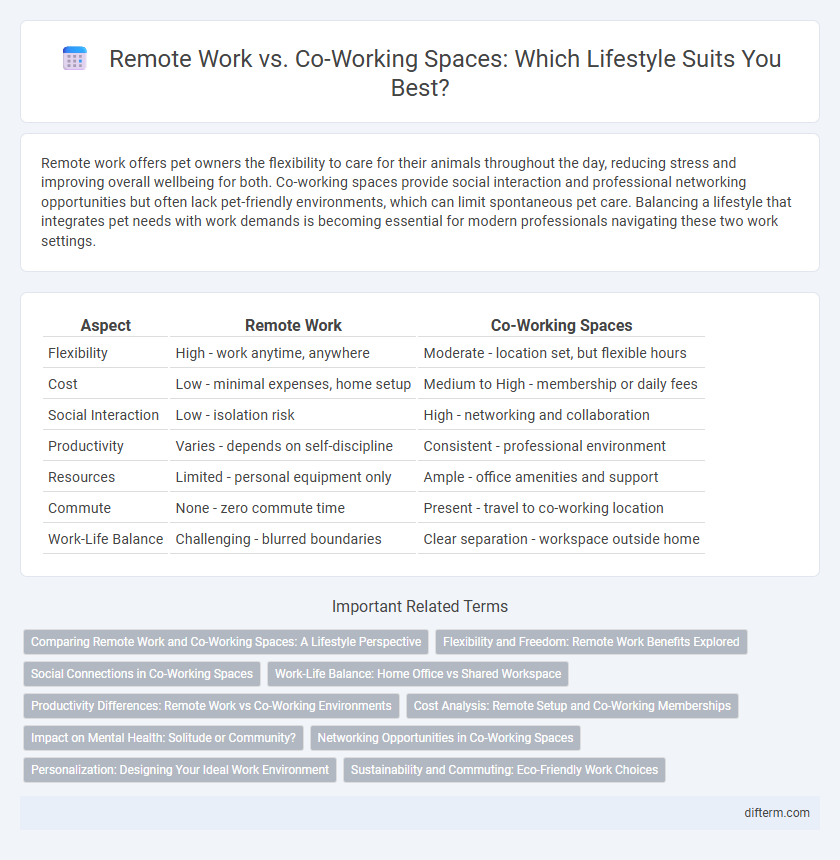Remote work offers pet owners the flexibility to care for their animals throughout the day, reducing stress and improving overall wellbeing for both. Co-working spaces provide social interaction and professional networking opportunities but often lack pet-friendly environments, which can limit spontaneous pet care. Balancing a lifestyle that integrates pet needs with work demands is becoming essential for modern professionals navigating these two work settings.
Table of Comparison
| Aspect | Remote Work | Co-Working Spaces |
|---|---|---|
| Flexibility | High - work anytime, anywhere | Moderate - location set, but flexible hours |
| Cost | Low - minimal expenses, home setup | Medium to High - membership or daily fees |
| Social Interaction | Low - isolation risk | High - networking and collaboration |
| Productivity | Varies - depends on self-discipline | Consistent - professional environment |
| Resources | Limited - personal equipment only | Ample - office amenities and support |
| Commute | None - zero commute time | Present - travel to co-working location |
| Work-Life Balance | Challenging - blurred boundaries | Clear separation - workspace outside home |
Comparing Remote Work and Co-Working Spaces: A Lifestyle Perspective
Remote work offers flexibility and personalized environments that enhance productivity for many professionals, while co-working spaces provide social interaction and collaborative opportunities that combat isolation. Studies show that 70% of remote workers appreciate the freedom of managing their own schedules, yet 60% of co-working space users report increased motivation and networking benefits. Balancing solitude with social engagement is key to optimizing work-life integration in today's evolving professional landscape.
Flexibility and Freedom: Remote Work Benefits Explored
Remote work offers unparalleled flexibility, enabling employees to tailor their schedules and work environments to individual preferences, which enhances productivity and work-life balance. Unlike co-working spaces, remote work eliminates commuting time and geographical restrictions, providing freedom to work from any location. This autonomy supports diverse lifestyle choices and fosters a more personalized approach to managing professional and personal responsibilities.
Social Connections in Co-Working Spaces
Co-working spaces foster valuable social connections by providing a collaborative environment where professionals from diverse industries interact regularly. Unlike remote work, which can lead to isolation, co-working spaces encourage networking, idea exchange, and community building that enhance creativity and productivity. The accessibility of in-person social engagement in co-working hubs significantly boosts motivation and emotional well-being among workers.
Work-Life Balance: Home Office vs Shared Workspace
Remote work from a home office offers flexibility that enhances work-life balance by eliminating commute times and allowing personalized schedules. Shared workspaces foster social interaction and reduce feelings of isolation, which can improve mental well-being and productivity. Balancing the solitude of remote work with the collaborative environment of co-working spaces can optimize overall lifestyle and professional satisfaction.
Productivity Differences: Remote Work vs Co-Working Environments
Remote work offers flexibility and personalized environments that can enhance focus, while co-working spaces provide structured settings with fewer distractions and opportunities for professional networking. Studies show productivity varies widely depending on individual work styles, with remote workers excelling in self-motivated tasks and co-working employees benefiting from collaborative and social interactions. Employers report a 20% increase in output when workers utilize co-working spaces due to reduced isolation and enhanced accountability.
Cost Analysis: Remote Setup and Co-Working Memberships
Remote work typically requires initial investments in home office equipment, high-speed internet, and utility costs, but reduces daily commuting expenses, leading to potential long-term savings. Co-working memberships often come with fixed monthly fees that include amenities such as meeting rooms, networking opportunities, and maintenance, which can streamline operational costs for freelancers and startups. Careful cost analysis reveals that while remote setups may offer greater flexibility and lower overhead, co-working spaces provide structured environments that might justify higher expenses through increased productivity and collaboration.
Impact on Mental Health: Solitude or Community?
Remote work offers solitude that can enhance focus and reduce social anxiety, but prolonged isolation may increase feelings of loneliness and stress. Co-working spaces foster social interaction and a sense of community, which can boost mental well-being and reduce burnout through shared experiences. Balancing solitary work with community engagement is crucial for maintaining mental health in modern professional lifestyles.
Networking Opportunities in Co-Working Spaces
Co-working spaces foster vibrant networking opportunities by bringing together diverse professionals from various industries, enabling spontaneous collaborations and knowledge sharing. These environments host regular events, workshops, and social gatherings that facilitate meaningful connections and professional growth. Unlike remote work settings, co-working spaces create physical proximity that enhances relationship-building and opens doors to new business ventures.
Personalization: Designing Your Ideal Work Environment
Remote work offers unparalleled personalization, allowing individuals to tailor lighting, ergonomic furniture, and ambient noise to suit their productivity needs. Co-working spaces provide a blend of social interaction and customizable options such as private pods, adjustable desks, and community-focused layouts that enhance creative collaboration. Prioritizing personal comfort and functional design in either setting significantly boosts focus, well-being, and overall work satisfaction.
Sustainability and Commuting: Eco-Friendly Work Choices
Remote work significantly reduces carbon emissions by eliminating daily commutes, contributing to lower air pollution and decreased fossil fuel consumption. Co-working spaces offer a sustainable alternative by consolidating resources and enabling shared transportation options, which minimizes the environmental footprint compared to traditional office setups. Choosing eco-friendly work options supports urban sustainability goals and promotes greener lifestyle practices.
remote work vs co-working spaces Infographic

 difterm.com
difterm.com